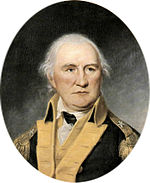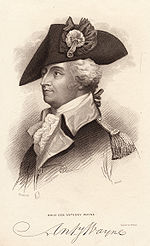The 6th Pennsylvania Regiment, first known as the 5th Pennsylvania Battalion, was a unit of the United States of America (U.S.) Army, raised December 9, 1775, at Philadelphia, Pennsylvania, for service with the Continental Army. The regiment would see action during the New York Campaign, Battle of Brandywine, Battle of Germantown, Battle of Monmouth, and Green Spring. The regiment was disbanded on January 1, 1783.
The 11th Pennsylvania Regiment or Old Eleventh was authorized on 16 September 1776 for service with the Continental Army. On 25 October, Richard Humpton was named colonel. In December 1776, the regiment was assigned to George Washington's main army and was present at Assunpink Creek and fought at Princeton in January 1777. During the spring, the unit assembled at Philadelphia, Pennsylvania in a strength of eight companies. The soldiers were recruited from Philadelphia and four nearby counties. On 22 May 1777, the regiment became part of the 2nd Pennsylvania Brigade. The 11th was in the thick of the action at Brandywine, Paoli, and Germantown in 1777. It was present at White Marsh and Monmouth. On 1 July 1778, the unit was consolidated with the 10th Pennsylvania Regiment, and the 11th Regiment ceased to exist. Humpton took command of the reorganized unit.
The 8th Virginia Regiment or German Regiment was an infantry unit that served in the Continental Army during the American Revolutionary War. Authorized in January 1776, the regiment was raised from men of several northwestern counties in the strength of 10 companies. Its first commander was Colonel Peter Muhlenberg, a clergyman and militia leader. The unit marched to defend Charleston, South Carolina in 1776, but saw no fighting. At the start of 1777, the 8th Virginia moved to join George Washington's main army. When Muhlenberg was promoted to general officer, Colonel Abraham Bowman took command of the unit.
The 2nd North Carolina Regiment was an American infantry unit that was raised for the Continental Army during the American Revolutionary War. In 1776 the regiment helped defend Charleston, South Carolina. Ordered to join George Washington's main army in February 1777, the regiment subsequently fought at Brandywine and Germantown during the Philadelphia Campaign. After most other North Carolina regiments were sent home to recruit, the 1st and 2nd Regiments remained with the main army and fought at Monmouth in June 1778. The regiment was transferred to the Southern Department and was captured by the British army in May 1780 at the Siege of Charleston. Together with the 1st Regiment, the unit was rebuilt and fought capably at Eutaw Springs. The 2nd was furloughed in April 1783 and officially dissolved in November 1783.
The following units and commanders fought in the Battle of Paoli during the American Revolutionary War. The Battle of Paoli was part of the Philadelphia campaign of the American Revolutionary War fought on September 21, 1777, in the area surrounding present-day Malvern, Pennsylvania.

At the Battle of Brandywine on September 11, 1777 a colonial American army led by General George Washington fought a British-Hessian army commanded by General William Howe, 5th Viscount Howe. Washington drew up his troops in a defensive position behind Brandywine Creek. Howe sent Lieutenant General Wilhelm von Knyphausen's 5,000 troops to demonstrate against the American front at Chadd's Ford. Meanwhile, Lieutenant General Charles Cornwallis took 10,000 troops on a wide flank march that crossed the creek and got in the rear of the American right wing under Major General John Sullivan. The Americans changed front but Howe's attack broke through.
Edward Mathew began his military career in the British Army as a commissioned officer. By the time of the American Revolutionary War he had risen to the rank of colonel. Promoted to brigadier general, he was assigned to command the elite Brigade of Guards in the American campaign. In 1776 he led the Guards at Long Island, Kip's Bay, and Fort Washington where he spearheaded one of the assault forces. In the Philadelphia Campaign, he commanded his brigade at Brandywine, Germantown, White Marsh, and Monmouth. As a major general, he took part in the highly successful Chesapeake raid on Virginia ports in 1779. He led one of the columns in action at Battle of Springfield in 1780. He commanded in the West Indies in 1782 and became a full general in 1797. His beloved daughter Anna predeceased him in 1795. Mathew is likely to have been the model for a character in one of Jane Austen's novels.
Philippe Hubert, Chevalier de Preudhomme de Borre joined the French Army in 1740 and served in the War of the Austrian Succession. During the American Revolutionary War he traveled to America where he was presented as a military expert. Promoted to general officer, his career as a Continental Army officer was brief and undistinguished. He resigned under a cloud and returned to France in 1779. His career ended in obscurity.

The 2nd Continental Artillery Regiment also known as Lamb's Continental Artillery Regiment was authorized on 1 January 1777 as Colonel John Lamb's Continental Artillery Regiment. As originally constituted, the regiment included 12 artillery companies from New York, Connecticut, and Pennsylvania. The bulk of the regiment served in the Hudson Highlands, though some companies fought with George Washington's main army from 1777 to 1779.

Thomas Proctor or Thomas Procter commanded the 4th Continental Artillery Regiment during the American Revolutionary War. He was born in County Longford, Ireland, emigrated to British America, married in 1767 in Philadelphia, Pennsylvania, and joined the carpenter's guild in 1772. Receiving a commission as an artillery captain in October 1775, he proceeded to raise a company of Pennsylvania state artillery. After a second company was recruited, Proctor was promoted to major and both companies joined George Washington's army. Proctor led his gunners at Princeton in January 1777. The state authorities elevated Proctor to the rank of colonel and charged him to recruit an eight-company Pennsylvania State Artillery Regiment a month later.
The 4th Continental Artillery Regiment, also known as Reign's Continental Artillery Regiment, was an American military unit during the American Revolutionary War. The regiment became part of the Continental Army on 10 June 1777 as Colonel Thomas Proctor's Continental Artillery Regiment. It was made up of eight artillery companies from eastern Pennsylvania. At the time of the regiment's formation, two companies were already in existence, one from as early as October 1775. One company served at Trenton in December 1776 where it performed well in action. In February 1777, Pennsylvania expanded its two-company battalion into an eight-company regiment. After officially joining the Continental Army, the regiment saw much fighting in the Philadelphia campaign in late 1777. Elements of Proctor's Regiment fought at Monmouth in June 1778 and joined the Sullivan Expedition in summer 1779.

Walter Stewart was an Irish-born American general in the Continental Army during the American Revolutionary War.
Hartley's Additional Continental Regiment was an American infantry unit of the Continental Army that served for two years during the American Revolutionary War. The regiment was authorized in January 1777 and Thomas Hartley was appointed its commander. The unit comprised eight companies from Pennsylvania, Maryland, and Delaware. When permanent brigades were formed in May 1777, the regiment was transferred to the 1st Pennsylvania Brigade. Hartley's Regiment fought at Brandywine, Paoli, and Germantown in 1777. The unit helped defend the Pennsylvania frontier against indigenous raids in the Summer and early Fall of 1778. In January 1779, following a resolution of the Continental Congress the regiment, along with Patton's Additional Continental Regiment and part of Malcolm's Additional Continental Regiment, were combined to form a complete battalion known as the "New" 11th Pennsylvania Regiment. The 11th participated in the Sullivan Expedition in the summer of that year. In January 1781 the 11th merged with the 3rd Pennsylvania Regiment and ceased to exist.
Patton's Additional Continental Regiment was an American infantry unit that existed for two years during the American Revolutionary War. Authorized on 11 January 1777, the unit was recruited from the colonies of Pennsylvania, New Jersey, and Delaware. Raised by Colonel John Patton in early 1777, it saw service with the Continental Army during the Philadelphia Campaign. In January 1779 the regiment was absorbed by Hartley's Additional Continental Regiment, except for one company which joined the 1st Delaware Regiment.
Grayson's Additional Continental Regiment was an American infantry unit that served for two years and three months in the Continental Army during the American Revolutionary War. Like other Additional Regiments, Grayson's remained directly under George Washington's control, unlike state regiments. Authorized in January 1777, the unit's nine companies were recruited from the colonies of Virginia, Maryland, and Delaware. Raised by Colonel William Grayson, the regiment participated in actions in Northern New Jersey in early 1777, at Brandywine in September 1777, at Germantown in October 1777, and at Monmouth in June 1778. In April 1779 the regiment was absorbed by Gist's Additional Continental Regiment and ceased to exist.
Richard Parker was an American colonel who fought in the American Revolutionary War. Son of prominent Virginia jurist Richard Parker, Parker received an officer's commission in a Virginia regiment early in the conflict. He probably was present at Great Bridge and Norfolk. Promoted to major, he fought at Trenton in December 1776 and commanded the regiment at Second Trenton and Princeton in January 1777. At Brandywine in September 1777 he led a detachment of light infantry in delaying the British. The next month he fought at Germantown. Promoted to colonel at Valley Forge, he led a picked detachment at Monmouth in June 1778. In May 1779, George Washington ordered him back to Virginia to recruit a new regiment. After being sent south with a new unit of reinforcements for Charleston, South Carolina in late 1779, he died of wounds received at the Siege of Charleston in 1780.
The "German Battalion" was an infantry formation of the Continental Army during the American Revolutionary War. Authorized in May 1776 as an extra Continental regiment, the battaltion recruited ethnic Germans from Maryland and Pennsylvania.
Spencer's Additional Continental Regiment, sometimes referred to as the 5th New Jersey Regiment, was an American infantry unit that served for four years in the Continental Army during the American Revolutionary War. The Continental Congress authorized sixteen "Additional" Continental Regiments in late 1776 and Colonel Oliver Spencer accepted command of this regiment with rank from January 15, 1777.

Oliver Spencer was a New Jersey officer during the American Revolutionary War and received a special commission to enlist and lead one of 16 Additional Continental Regiments. He was born in Connecticut and later moved to New Jersey, where he married Anna Ogden and became a tanner. He joined the revolutionary cause and engaged a British force in December 1776 as a major of New Jersey militia. On 15 January 1777 during the Forage War, his militiamen captured 70 German mercenaries. That month George Washington authorized him to recruit Spencer's Additional Continental Regiment. As colonel, he led this unit at Brandywine and Germantown in 1777 and Monmouth in 1778. His regiment participated in the Sullivan Expedition in 1779 and was disbanded at the beginning of 1781. The conflict having ruined his home and his tanning business, he moved to Ohio, where he served as a probate judge and militia commander. He was the nephew of General Joseph Spencer.







